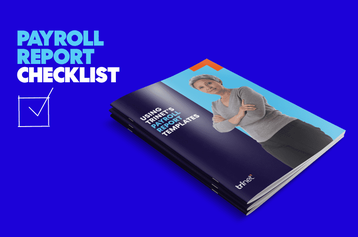
Whether you’re building a business for the first or seasoned by years of experience, there are a myriad of terms to know when it comes to remain in compliance. Whether you’re brushing up on your knowledge or navigating employer waters for the first time, we’re here to break down complex processes to make kicking off your dream just a little bit easier. First on the list? EINs. An Employer Identification Number (EIN), also known as a Federal Tax Identification Number, is used by the Internal Revenue Service (IRS) to identify a business entity. An entity will require an EIN if any of the following conditions apply:
- The entity has employees;
- The entity operates as a corporation or a partnership;
- The entity files any of these tax returns: employment, excise, alcohol, tobacco and firearms;
- The entity withholds taxes on income, other than wages, paid to a non-resident alien;
- The entity has a Keogh* plan.
- The entity is involved with any of the following types of organizations:
- Trusts, except certain grantor-owned revocable trusts, IRAs, Exempt Organization Business Income Tax Returns
- Estates
- Real estate mortgage investment conduits
- Non-profit organizations
- Farmers' cooperatives
- Plan administrators
The entity must provide their EIN on every form/communication that is sent to the Internal Revenue Service (IRS) or the Social Security Administration (SSA). An entity should have only one EIN for that same business entity.
Changing Your Federal Employer Identification Number (EIN)
The IRS will require a new EIN when your business undergoes significant changes. Examples of this include activities such as a sole proprietorship deciding to take on new partners; a corporation receiving a new charter from the secretary of state; or, a partnership deciding to incorporate.
Reporting W2s and IRS Form 941
The IRS uses EIN’s to identify and track employers and their employees. Form 941 is filed quarterly by EIN with the IRS to report wages and federal payroll taxes (Federal Income, Social Security, and Medicare Taxes). In many cases**, federal wage and tax limits cannot be carried over to a new EIN. This means employees who have hit the 2017 Social Security Wage limit of $ 127,200 in one EIN may need to start over and have Social Security taxes deducted again in a new EIN. Because employee wages are tracked by EIN, an EIN change in the middle of the year could also mean employees would receive two W2’s for the year: one for each EIN. If this is the case, the employer should notify employees to expect two W2’s for that year and to include both W2’s in their tax filings.
Notifying your Payroll Vendor of EIN Change
It is essential to inform payroll vendors of an EIN change as soon as possible so that the tax deposits and tax filings can be made with the correct EIN. A change in EIN can often mean that a payroll vendor will need to implement a whole new company code, which can take weeks. Advanced notice is imperative.
Miss-Timing EIN Changes can be Costly
The IRS balances tax filings and tax deposits by EIN. If the change of an EIN is miss-timed, differences can occur between the IRS deposits and filings. These out of balances can result in tax notices that can be complex and difficult to resolve and may result in penalties by the IRS.
Consider a January 1 effective date for Business Structure Changes
Because a change in EIN has a significant impact on payroll, businesses should consider the timing of the changes to mitigate this impact. Acquisitions or changes of business structure that are effective on January 1, the beginning of the year, are ideal from a payroll tax perspective (always consult your tax advisor on the timing of business structural changes). A January 1 effective date will allow for a clean start of the year for tax reporting, with tax limits and multiple W2’s no longer an issue. Payroll vendors will still need advance notice, but the impact of the change will be far less burdensome.
Closing your Business Account with the IRS
An EIN is forever linked with the entity. When an EIN will no longer be used, the IRS can close the business account. The EIN will still be linked with the entity, but the IRS will know not to expect tax filings. This can help prevent IRS notices and penalties for failure to file tax returns. To close your business account, send a letter that includes the complete legal name of the entity, the EIN, the business address and the reason you wish to close the account. It is good if you can also include a copy of the EIN Assignment Notice that was issued when your EIN was assigned. You can mail the letter to the following address:
Internal Revenue Service Cincinnati, Ohio 45999 The IRS recommends following a checklist when closing an account. The IRS uses the EIN to identify a business entity. Changes to business structure can impact your business in unexpected ways, especially if a new EIN is required, and/or an EIN will no longer be used. The impact such a change has on payroll should be considered. Doing so can prevent potential headaches and penalties.
Helpful Links IRS-Do You Need a New EIN?
*A Keogh plan is a tax-deferred pension plan available to self-employed individuals or unincorporated businesses for retirement purposes. A Keogh plan can be set up as either a defined-benefit or defined-contribution plan, although most plans are defined as contributions.
**Certain exceptions exist, for example when a successor - predecessor rule applies. You should consult your tax advisor to determine the proper treatment.
This communication is for informational purposes only; it is not legal, tax or accounting advice; and is not an offer to sell, buy or procure insurance.
This post may contain hyperlinks to websites operated by parties other than TriNet. Such hyperlinks are provided for reference only. TriNet does not control such web sites and is not responsible for their content. Inclusion of such hyperlinks on TriNet.com does not necessarily imply any endorsement of the material on such websites or association with their operators.






